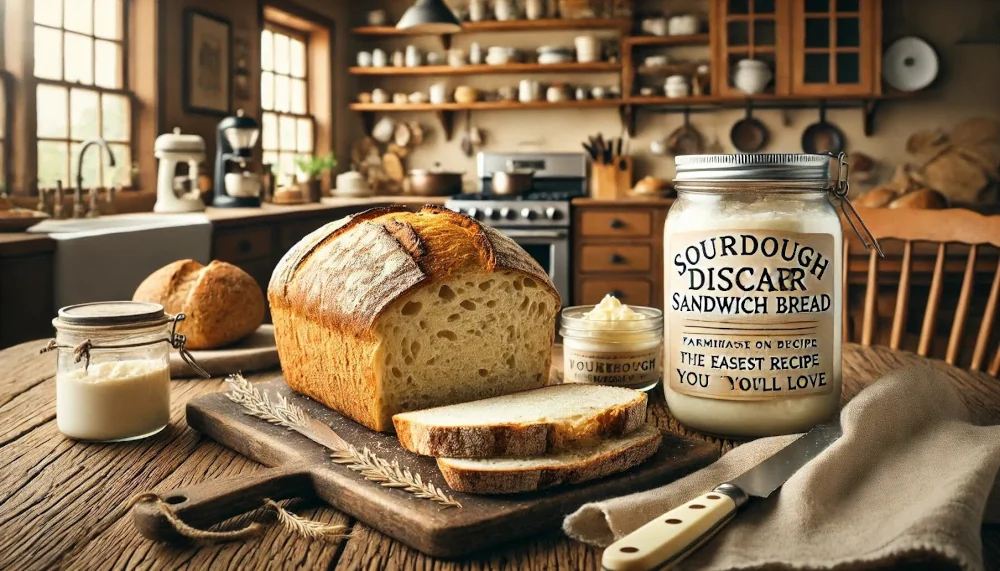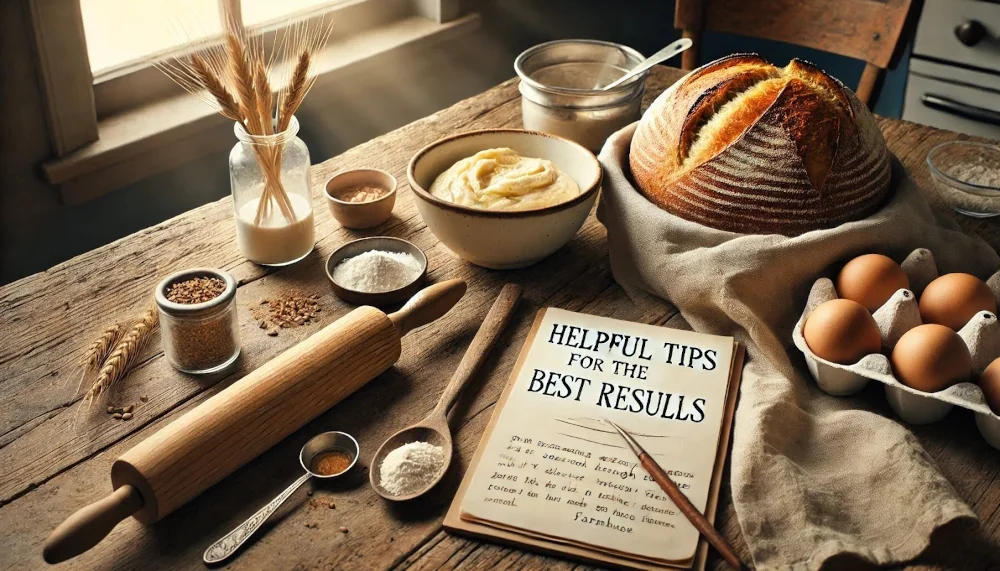Sourdough Discard Sandwich Bread Farmhouse on Boone

Baking with sourdough is something of a love affair. With rustic flavors, simple ingredients, and an unhurried fermentation process, it is very loved by home bakers.
While maintaining a sourdough starter, you must be aware of the following dilemmas: What should we do with all that sourdough that has been discarded? Instead of throwing it away, why not make soft, fluffy, beautiful sourdough discard sandwich bread?
Inspired by the charming Farmhouse on Boone style, this recipe is best for people who love wholesome, homemade bread.
This sourdough discard sandwich bread is a must-try when prepping the family sandwiches, toasting for breakfast, or just enjoying a slice with warm butter.
Why Do You Need It?
If you have ever had to keep a sourdough starter in good condition, you know it involves its fair share of regular feedings. In each feed, a portion is discarded so that the remaining portion is healthy.
Instead of throwing this out, the discard can instead be used to create other lovely baked goods: pancakes, muffins, crackers, and sandwich bread.
Benefits of adding Sourdough Discard:
- A hint of sour flavor
- Fermentation goodness
- Wonderful depth to baked goods
Now, let’s get to work: I will show you how to use your discard to make the best sandwich bread, as well as a bonus bagel recipe.
Sourdough Discard Bagel Recipe
This unique sourdough discard recipe will make your bagel crispy on the outside and chewy on the inside, and it will quickly become a go-to at your house.
Things You Need
- 1 cup sourdough discard
- 1 ½ teaspoons salt
- 1 tablespoon honey or sugar
- 1 packet (2 ¼ tsp) active dry yeast
- 3 ½ cups bread flour
- ¾ cup warm water
- 1 teaspoon baking soda (to churn water for boiling)
Toppings: sesame seeds, poppy seeds, or everything else, such as bagel seasoning.
Instructions
- Combine warm liquid water with honey and yeast before allowing it to develop foam during a 5-10 minute wait. The yeast requires a 5-10 minute period of sitting to become foamy.
- A large bowl contains the ingredients for sourdough. Discard with salt and flour as you mix them together. Using the yeast mixture will result in smooth dough after 8-10 minutes of kneading.
- The dough needs to rest for 1 hour under cover until it increases in volume up to double its initial size.
- Cut the dough into eight equal portions before turning each piece into a ball shape by inserting a hole through the middle.
- During the second rise, place the bagels under room temperature for thirty minutes while heating the oven to 425 °F.
- Place all bagels into boiling water solution with one teaspoon of baking soda for 30 seconds while flipping each side.
- After topping the boiled bagels, place them on parchment-lined baking sheets in a 425°F oven. Bake for 18-20 minutes until they turn golden brown.
Happiness is in your choice of homemade bagels, such delicious treats, when spread with cream cheese, butter, or whatever spread you enjoy.
Sourdough Sandwich Bread: The Ultimate Softness and Fluffiness

Now, we dive into the heart of this post: the best sourdough discard sandwich bread recipe. If you love Farmhouse on Boone, you’ll love this simple farmhouse-style way to bake bread.
This sourdough sandwich bread is different from traditional sourdough bread in that it adds commercial yeast to shorten the fermentation time and impart that wonderful sourdough taste.
This bread suits busy bakers who want homemade bread without having to wait for 24-plus hours for it to rise.
Why You Will Love It:
- The process takes care of itself because beginners who avoid long fermentation waits can still experience successful results.
- It is perfect for sandwiches or French toast.
- The recipe conserves all ingredients through its use of sourdough discard, which eliminates any type of wastage.
Sourdough Sandwich Bread: The Ultimate Softness and Fluffiness
Ingredients
- 2 ¼ Teaspoons Active Dry Yeast
- 2 Tablespoons Honey or Sugar
- 1 ½ Teaspoons Salt
- 4 Cups Bread Flour (plus more for dusting)
- 2 Tablespoons Butter (melted for brushing)
Things To Do
- Step 1: Activate the Yeast
A mixing bowl should contain warm water alongside honey (or sugar) and yeast before activation begins. Permit the mixture to remain for 5-10 minutes while the yeast creates foam.
The pan with yeast requires warm water and honey or sugar to verify that the yeast remains active before making the dough rise.
- Step 2: Mix the Dough
Stir the yeast mixture with salt, flour, and sourdough and discard. Stir the ingredients until the dough reaches a shaggy mass.
The dough requires 8 to 10 hand-kneading periods or 5 to 7 minutes of kneading with a dough hook attachment to develop a smooth, elastic quality.
- Step 3: First Rise
Set the dough inside a greased bowl while covering it with a wet towel for proofs lasting 1-1.5 hours until it expands to double in size.
- Step 4: Shape the Loaf
After it rises, you should punch the dough and then use it to create a loaf. The 9×5-inch loaf pan should receive a light coating of grease before adding the dough, which will then receive loose coverage from a towel.
- Step 5: Second Rise
After 30 to 45 minutes of the second rise time, let the dough achieve a pleasant peak above the edges of the pan. In the meantime, try to preheat your oven to 375°F.
- Step 6: Start Baking That Bread
Put the loaf into the oven for thirty-five to thirty-five minutes to achieve a golden brown top with an audible hollow sound. After baking, the warm loaf receives a butter brush application to create a soft, crusted surface with rich flavor.
- Step 7: Cool & Enjoy
The bread needs to finish its cooling process on a wire rack prior to being sliced. After cooling, you will experience the best homemade sandwich bread.
Helpful Tips for The Best Results

In order to make the most out of all the work you put into this process, we have prepared some really helpful ways to make it all worth it.
So, take a look:
- Flour should preferably be bread flour, which will produce a better structure and chew in the bread.
- Allowing the bread to rise a second time guarantees both light texture and airiness.
- A butter brush on the bread crust helps maintain both its texture and its tasty flavor.
How to Preserve It:
- Storing at room temperature involves placing the foods in appropriately sealed containers and maintaining them in this condition for between three to four days.
- The storage life in a fridge reaches one week, but duty might cause slight dehydration.
- You can freeze the food into slices and maintain it in an appropriate state for 3 months to create fast sandwiches.
Conclusion
At the end of the day, when the sun finally sets, all I have to say is that if you’re a lover of handcrafted farmhouse recipes, then this sourdough discard sandwich bread is just the perfect recipe for you.
It’s easy to make, ever so nice to eat, and a wonderful way to ensure extra discard does not go to waste. And with the included bagel recipe, you’ll have more ways to incorporate sourdough into your homemade creations.
So the next time your starter needs a little nourishment, have mercy on that discard and really treat it right the way it was meant to.
Happy Baking.
FAQs
So can I make the bread without yeast and use sourdough discard?
You can, but the fermentation will take at least 8 to 12 hours.
My bread turned out to be dense. What went wrong?
There is a strong possibility that the dough was not given enough time to rise.
Can I add seeds, herbs, or any other mix to his recipe?
Yes, why not? You can add sunflower, flax seeds, rosemary, and some shredded cheese to spice up your sandwich bread flavor.
